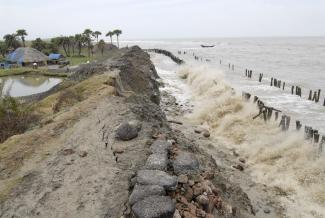Organic agriculture
Deluge impact

The Sundarbans have the largest continuous mangrove forest in the world, a UNESCO World Heritage Site that covers parts of Bangladesh and the Indian State of West Bengal. Tides, long shore currents, cyclones and monsoon rainfalls cause the landscape of this coastal area to change constantly. The Sundarbans are located in the southern Ganges Delta. Infrastructure tends to be poor, and the living conditions are very harsh. Many people have to rely on boats for all kinds of transport. Agriculture depends on rainfall. The Delta is tidal, so water from the rivers is saline and cannot be used for irrigation purposes. The threats of climate change have made things even more difficult for some 4.4 million people who live on the Indian side of the border. Global warming is considered the reason for the rising sea level as well as for more frequent and increasingly intense storms and cyclones.
The Sundarbans have been marked as one of the critically vulnerable coastal zones, both in the Indian Coastal Regulation Zone Notification of 2008 and the Fourth Assessment Report by the Intergovernmental Panel on Climate Change published in 2007. From 2007 to 2009, the Bay of Bengal witnessed three major storms. Sidr, Nargis and Aila wreaked havoc in Myanmar, Bangladesh and India. On 29 May 2009, cyclone Aila struck the Indian Sundarbans with 125 km/h wind speed. According to estimates, about 150 persons were killed in West Bengal and even more in Bangladesh. Waves rose as high as 15 meters.
Many villages and fields on the islands are below sea level and only protected by earthen embankments. Aila demolished 900 km of embankment in a single day. As a consequence, saltwater flooded half of the islands’ agricultural land. Farmers can no longer grow standard rice varieties there because of the salt in the soil. As a legacy of the green revolution in the 1960’s, most Indian farmers have learned to rely on high-input agriculture with high-yielding varieties. That is true of Sundarban farmers too. When they notice a decline in productivity, they tend to increase their use of chemical fertiliser. Doing so is useless, however, when salt has contaminated farmland.
Neither the Agriculture Department of West Bengal, nor the Government of India provided any help. Confronted with the extreme salinity of the soil caused by the cyclone, farmers started losing hope. They were unable to cope with the difficult situation.The failure of the authorities to offer support motivated a Kolkata-based civil society organisation, the Society for Environment and Development (ENDEV), to look for alternatives. ENDEV is mostly composed of professional people with expert knowledge in environmental issues. They had the idea to help local farmers by re-introducing traditional saline-tolerant paddy strains in order to make food production viable once more.
In search of traditional resources
Finding the right varieties, however, turned out to be quite a challenge. India’s biodiversity of traditional land races is eroding fast. Debal Deb, a member of ENDEV, is an expert in these matters. He runs a farm that aims to conserve India’s vanishing rice varieties in a different part of West Bengal. So far, his farm has managed to save some 600 land races. Deb and his team, moreover, encourage local people to practice organic farming and use traditional methods, such as multiple cropping.
Deb only had one salt-resistant land race on his farm, but he knew the names of others that Sundarban farmers used to cultivate because of this quality in the past. They are called “matla”, “nona bokra”, “talmugur”, “lal getu”, “sada getu” and “hamilton”.
Once the names of the traditional types of rice were identified, members of ENDEV started searching for them. It took the activists more than a year to find seeds of five varieties in various remote villages of the Sundarbans and at the National Bureau of Plant Genetic Resources (NBPGR) in New Delhi. They did not find Matla seeds, however, so this variety has probably been lost forever. Deb conducted experiments on his farm to test the limits of the five land races’ salt tolerance. It turned out that ”hamilton” was the most saline-tolerant variety.
The seed quantities that were available, however, were quite small. The NBPGR could only provide 100 grams of talmugur and nona bokra for example. It takes at least 250 kilogrammes to cultivate one acre of farmland in any given season. Accordingly, re-introduction of the varieties had to begin with quite limited scope.
The next step was to design a project to change farming methods and multiply the seed of all five salt-resistant varieties. ENDEV took the approach of microplanning for sustainable agriculture, which is about involving the communities concerned in planning and adapting measures to their needs. The approach is often supported by technically competent NGOs. ENDEV could rely on support from the National Council of Rural Institutes, which is based in Hyderabad and is funded by the Government of India, to get microplanning right.
In the Sudarbans, ENDEV cooperated with five community-based organisations:
- the World Wide Fund for Nature – India,
- the Lutheran World Service India Trust,
- the Tagore Society for Rural Development,
- the Joygopalpur Youth Development Centre and
- the Paschim Sridharkhati Jankalyan Sangha.
Collectively, these organisations reach about half a million village people in the Sundarbans. However, only a few farmers could actually participate in the saline-resistant rice project. ENDEV taught members of the community-based organisations appropriate farming methods that do not require any chemical fertiliser or pesticides.The first harvest was in 2011. Success was mostly satisfying, though there were problems on one island because the Monsoon rains set in late. The harvested seeds were carefully preserved in seed banks which the community-based organisations set up. In 2012, the salt-tolerant varieties could be made available to about three dozen farmers.
To promote the process, farmers meetings were held every month. Participating farmers reacted enthusiastically to the initiative. Villagers in Mathurapur even wrote a song in praise of the properties of the “miracle seeds”.
The ENDEV initiative provides some valuable lessons:
- Building on traditional knowledge and relying on rare but most valuable genetic resources is a promising approach to adapting to climate change.
- Collective action can achieve tangible results and a change for the better in a seemingly desperate situation.
- Farmers are willing and even eager to cultivate salt-tolerant varieties in a vulnerable area like the Sundarbans, so similar initiatives should work out in other regions as well.
- Microplanning can lay the foundation for replicating sustainable agriculture methods.
- ENDEV has shown that a small group of people can make a difference.
- Traditional varieties need to be cultivated systematically for otherwise it will always take a long time to multiply enough seeds to re-introduce them in crisis areas on a large scale.
A.K. Ghosh is a former director of the Zoological Survey of India and the founder-president of the Society for Environment and Development (ENDEV), a non-governmental organisation based in Kolkata. cedkolkata@yahoo.com












